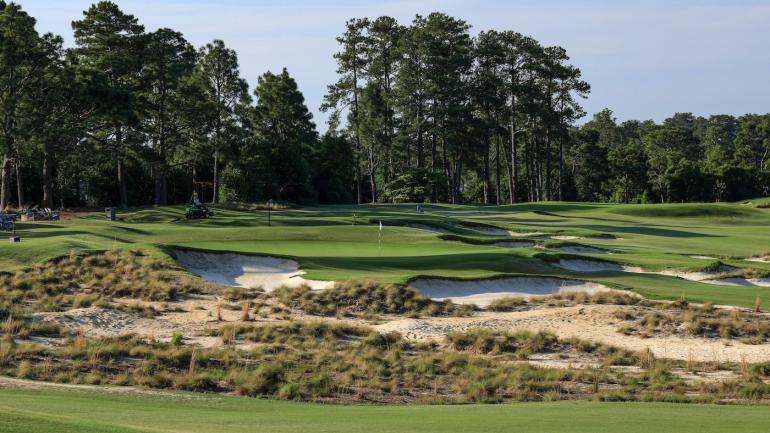
The USGA recently made Pinehurst No. 2 one of its primary sites to host men's U.S. Opens for the foreseeable future (and unforeseeable future). U.S. Opens are slated to be played at the famous course in North Carolina in 2024, 2029, 2035, 2041 and 2047. Rory McIlroy will be 58 years old in 2047.
The intimation is clear: Pinehurst No. 2 is a golf course worthy of the nation's championship. It would be difficult to argue otherwise. The Donald Ross design, which sits among nine other courses at the Pinehurst resort, has stood the test of time and remains one of the crown jewels in this country. It's also one of few old-school golf courses big enough and difficult enough to challenge the best players in the world.
Pinehurst No. 2 has hosted a PGA Championship, a Ryder Cup, the Tour Championship, three U.S. Amateurs, the U.S. Senior Open, the U.S. Women's Open and now its fourth men's U.S. Open this week.
Here's what you need to know about this classic venue going into the 2024 U.S. Open.
1. Degree of difficulty is high: In three completed men's U.S. Opens, four golfers have ever finished under par. There are a number of USGA-related reasons for this. The greens -- as you're about to hear 10,000 times in the week -- are difficult to hold because they're shaped like upside down bowls. And depending how much water Pinehurst gets, it can absolutely cook. It's the type of course that turns brown and gray and purple during a major championship week, which can be awesome.
Last year's U.S. Open at Los Angeles Country Club was considered too easy by some, especially after the major championship single-round record of 62 was tied twice in the first round. There will be no 62s or even any sniffs at a number that low this time around. The best score in 2014 was 65, which, incredibly, was shot twice by Martin Kaymer in the first two rounds. There was only one 66 (Daniel Berger in Round 4). This week, depending how much the USGA decides to dial it up, should be destructive.
2. Donald Ross' best: The list of Donald Ross courses is almost comically impressive: Seminole, Oakland Hills, Inverness and Oak Hill among them. Still, Pinehurst No. 2 is generally considered the best of his best. "The whole golf course was a most pleasant and testing golf course," Ben Hogan once said. "It's a real test of golf. The North and South Open was a 'major' then. Pinehurst was a golf Mecca."
Ross' designs were not complicated, but they were almost beautiful in their simplicity. Here's how his design of No. 2 was once described.
Borrowing from what he learned growing up on the links of Dornoch, Scotland, Ross made the crowned green his trademark. He was a detail man who took great patience to make sure every slope and break met his approval. All his bunkers looked like they hadn't been built at all, but had been made by the hands of nature. There is a seamless, timeless quality to Donald Ross golf courses that required very little earth-moving to construct.
Pinehurst No. 2 is a perfect example. Water comes into sight on only one hole, and it is not in play. The course is not particularly long, the rough is native sandscape and wire grass, and it is almost impossible to lose a golf ball. Yet any golfer who goes around close to his or her handicap will have had a good day.
That's a heck of a thing to be said a golf course's architecture. Much of it is what Ben Crenshaw and Bill Coore leaned on when they restored it back in 2011, ripping out much of the rough that permeated at the 1999 and 2005 U.S. Opens. The 2014 U.S. Open is an example of how the course was intended to look and play with sandy waste areas and weird lies in the "rough."
3. Those greens: Among a handful of defining features of Pinehurst, the greens are probably the most prominent one. As this video shows, the greens at Pinehurst are Augusta National-like in that they are big visually but small when it comes to where one can hit the ball to score on them.
But it's not just the greens' shapes, of which it was said about Ross, "[He was] a detail man who took great patience to make sure every slope and break met his approval." It's also the surroundings, which protect scoring at Pinehurst.
Here's how Garrett Morrison of the Fried Egg said it recently.
What I found more impressive than the severity of the runoffs at the edges of the greens, however, was the intricate contouring of the short-grass surrounds.
On the first hole, for instance, there are two closely mown mounds just below the ledge on the right side of the green. When players miss right, their ball will not only kick right but also potentially end up in a fiddly lie on the side of one of the hummocks. These kinds of details lend variety and complexity to Pinehurst No. 2's short-game test.
You know who has the second best short game in 2024? Yep, the same guy who won the Masters and is currently the No. 1 player in the world.
4. Solid winners but elite runners up: Here's a weird Pinehurst stat. Payne Stewart (1999), Michael Campbell (2005) and Kaymer (2014) are all winners on the course; they have totaled 15 PGA Tour wins between them. Phil Mickelson (1999), Tiger Woods (82), and the duo of Rickie Fowler and Erik Compton (2014) were their respective runners up; they have totaled 133 PGA Tour wins between them.
Pinehurst is the type of golf course that can reward great golf shots and create real separation on leaderboards, which is the reason for a bit of randomness in the winners. No lead is safe, though, which makes this event at this course a blast.
In 2005, three of the top six on the leaderboard shot in the 80s on Sunday. Retief Goosen held the third-round lead by three shots and still lost to Campbell by eight. Jason Gore was T2 and three back going into the final round; he lost to Campbell by 14. This year's event will be a thrill until the end.
5. The perfect rough: In a recent interview on Golf Channel, USGA chief championship officer John Bodenhamer talked about how Donald Ross said Pinehurst had "the perfect rough." Why? It creates randomness, which is what pros hate the most.
"We love it because it creates a little bit of anxiety or fear if you miss a fairway," added Bodenhamer.
This year will look quite a bit different than, say, Winged Foot or what some people think of as "typical" U.S. Open rough, but it should contribute to the difficulty of the golf course because of lies that prohibit players from understanding how the ball will react when struck. Combine that with the bowled greens, and chaos can ensue.

















